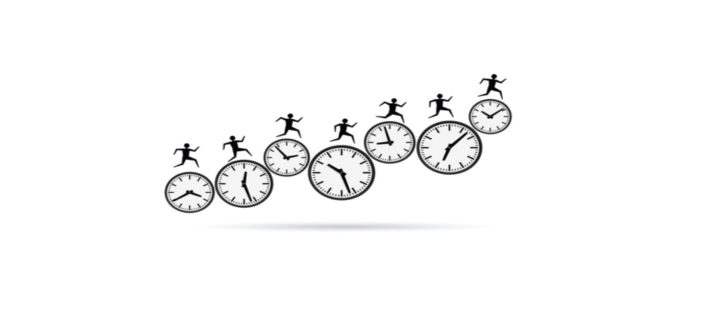When Cindy McGovern gets home from her day job, the real work begins. She’s been on the run since waking at 4:45 a.m. She’s put in a full day, juggling interviews and production schedules for the employee newsletter she runs. She’s endured a harrowing hour-long commute between work and her Northern Virginia in USA home.
Then the fun starts.
“What do you have for homework?” Cindy asks breathlessly as she packs a snack for ten-year-old Brian and eight-year-old Megan.
It’s after 5:30. There’s no time for a meal — or homework — or conversation. Cindy just wants to get evening operations underway, and not let her children go hungry. Brian plays baseball and Megan soccer. So if it’s not one sport, it’s the other. And if it’s not practiced, there’s a game. Other evenings, there are Scouts. Tonight, the children have to change into their sports clothes.
Later they’ll have dinner — even if it’s just sitting down together for 20 minutes over hot dogs or frozen pizza. Then Megan and Brian will do their homework at the kitchen table as Cindy cleans up. They’ll shower, make lunches, and prepare for the next day. The kids won’t be in bed until 9:45. Cindy will be asleep a half-hour later. She’ll collapse, exhausted.
Today’s typical mother struggles to balance careers at home and elsewhere. She often worries about a “family-time famine” — not enough time with her children — even though recent studies show it isn’t her children who are starving for attention. She’s the one.
According to a 1998 University of Maryland study, the average American mom today spends about the same time with her children as the stay-at-home moms of the 1960s — 5.8 waking hours a day, versus 5.6 hours back in the days of Wally and the Beav.
How does the modern mom do it? By taking time off work. By skipping meals. By stealing hours from herself. By putting off friends and her husband. By grooming herself in traffic on the way to her job. She keeps herself awake, sleeping six hours less each week than the average stay-at-home mom.
But no matter what she does, the modern employed mother still has 12 fewer hours of free time each week. She asks her spouse to help more — but still spends more time than he does on the chores and children. And she hardly ever relinquishes June Cleaver’s territory — cooking, cleaning, shopping.
Working Round the Clock
Though her schedule is packed, the average American mom keeps striving to do more for the kids, putting her own needs second. We all would recognize her. She comes in all stripes — single, married, stay-at-home, two-income — in all of whom University of Texas researcher Lorraine Walker has identified “a pattern of self-neglect.” Social psychologist Carin Rubinstein prefers the term “sacrificial mothering.”
Why do women neglect themselves? Could it be the many changes to body and mind that begin with giving birth itself? Are women similar to a species of bird that fakes lameness to divert a predator from their nest, or the octopus, which tends her eggs so diligently she starves herself? Is it an inheritance from ancestors or simply from one’s own mother? Do psychological effects drive women to deny themselves — guilt for separating from children to go to work, or, as increasingly happens, for separating from the child’s father? Do hormones call the shots?
Such causes of a mothers self-neglect are debatable. The potential consequences are not.
The Stress Factor
Researchers now know that a woman’s struggle to balance her life with the lives of those she loves can impair more than her sense of well-being. Medical science has established that unrelenting stress weakens the body’s defenses against sickness, threatens the cardiovascular system, and contributes to headaches, backaches, skin diseases, gastrointestinal distress, insomnia, and high blood pressure.
Stress also can trigger depression — a possible explanation for why more women suffer depression disorders than men. During the first year as a mother, vulnerability for depression rises dramatically. All told, 12 percent of women suffer from a depressive disorder, about double the number of men.
Also plausible, though less studied, are the effects of stress on almost every disease, including respiratory and reproductive disorders. Stress increases the odds of injury and even susceptibility to the viruses that cause colds. A recent study found that stress lasting more than one month doubled the risk of getting a cold.
“Stress is one of the most important — and least appreciated — health hazards of the current age. It is particularly important for women as they try to juggle so many roles,” says Marc B. Schenker, a professor of epidemiology and preventive medicine at the University of California at Davis. “Society has not adequately addressed this.”
Notes Harvard Medical School professor Alice Domar, director of the Mind/Body Medical Institute at Beth Israel Deaconness Medical Center in Boston: “Sixty percent of American women say stress is the single worst problem in their lives. They feel overwhelmed. They feel unhealthy. And, the fact is — many are.”
Cautions University of California psychologist Carolyn Pape Cowan, who studies how adult relationships and stress affects children: “You can’t be a good mother unless you’re on solid ground yourself. And your kids won’t do well, either.” ♦




